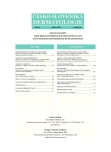Môže Scedosporium apiospermum spôsobiť onychomykózu?
Authors:
A. Volleková 1,2; J. Őlvédyová 3; M. Sládeková 2; M. Lisalová 2
Authors‘ workplace:
Ústav mikrobiológie, LF Slovenskej zdravotníckej univerzity, Bratislava, SR, prednosta doc. RNDr. Viktor Majtán, mim. prof.
1; Mykologické oddelenie HPL, spol. s r. o., Bratislava, SR, riaditeľ MUDr. Juraj Hanzen
2; Neštátna dermatovenerologická ambulancia, Malacky, SR
3
Published in:
Čes-slov Derm, 86, 2011, No. 2, p. 83-89
Category:
Clinical and laboratory Research
Overview
Background:
Scedosporium apiospermum is known as a causal agent of systemic or subcutaneous mycoses but superficial skin infections are unusual. In 2007–2010, this fungus without dermatophytes was isolated from big toe nails of ten patients (aged 42 to 78 years) suffered from onychomycosis.
Aim:
To evaluate the role of S. apiospermum in nails.
Results:
In only one woman S. apiospermum was confirmed by direct microscopy (hyphae and typical Scedosporium conidia) and also by culture in two successive nail specimens and thus, it was regarded as etiological agent of distal-lateral onychomycosis. In other two patients with the same findings in nails, S. apiospermum might be regarded only a suspect causal agent and, also in seven cases without typical conidia the fungus was considered as a nail contaminant beacuse unrepeated mycological examination before treatment. During peroral terbinafine therapy (250 mg o.d., 12 weeks, monitored in two patients) nails improved partially and/or transitory, though onychomycosis relapsed soon after treatment.
Conclusions:
S. apiospermum may be unfrequently the etiologic agent of onychomycosis, but it is mostly found in an abnormal-appearing nails as a contaminant. Dermatologist and clinical mycologist collaboration are necessary for accurate determination of S. apiospermum role in nail plates.
Key words:
Scedosporium apiospermum – onychomycosis – etiologic agent – contaminant – terbinafine
Sources
1. ELLIS, D. H., WATSON, A. B., MARLEY J. E., WILLIAMS, T. G. Non-dermatophytes in onychomycosis of the toenails. Br. J. Dermatol., 1997, 136, 4, p. 490–493.
2. ENGLISH, M. P. Nail and fungi. Br. J. Dermatol., 1976, 94, p. 697–701.
3. FIRDOVÁ, M., TKÁČOVÁ, E., JESENSKÁ, Z., MINOVÁ, M. Mycotic keratitis with uveitis cause by Scedosporium apiospermum. Česk slov oftalmol., 1997, roč. 53, č. 3, s. 248–251
4. GARCÍA-MARTOS, P., DOMÍNGUEZ, I., MARÍN, P., LINARES, M., MIRA, J., CALAP, J. Onychomycoses caused by non-dermatophytic filamentous fungi in Cádiz. Enferm. Infec. Microbiol. Clin., 2000, 18, 7, p. 319–324.
5. GILGADO, F., SERENA, C., CANO, J., GENÉ, J., GUARRO, J. Antifungal susceptibilities of the species of the Pseudallescheria boydii complex. Antimicrob. Agents Chemother., 2006, 50, 12, p. 4211–4213.
6. GUARRO, J., KANTARCIOGLU, S., HORRÉ, R., RODRIGUEZ-TUDELOS, J. L., ESTRELLA, M. C., BERENGUER, J., HOOG, G. S. De. Scedosporium apiospermum: changing clinical spectrum of a therapy-refractory opportunist. Med. Mycol., 2006, 44, 4, p. 295–327.
7. HOOG, G. S. DE GUARRO, J., GENE, J., FIGUERAS, M. J. Atlas of Clinical Fungi. 2nd ed, CBS, Utrecht, The Netherlands, 2000, 1126 s.. ISBN 90-70351-26-9.
8. ISSAKAINEN, J., HEIKKILÄ, H., VAINIO, E., KOUKILA-KÄHKÖLÄ, P., CASTREN, M., LIIMATAINEN, O., OJANEN, T., KOSKELA, M., MEURMAN, O. Occurrence of Scopulariopsis and Scedosporium in nails and keratinous skin. A 5-year retrospective multi-center study. Med. Mycol., 2007, 45, 3, p. 201–209.
9. KARAARSLAN, A., ARIKAN, S., KARAARSLAN, F., CETIN, E. S. Skin infection caused by Scedosporium apiospermum. Mycoses, 2003, 46, 11–12, p. 524–526.
10. KUWANO, A., YOSHIBARA, T., TAKATORI, K., KOSUGE, J. Onychomycosis in white line disease in horses: pathology, mycology and clinical features. Equine Vet. J., 1998, 26, (suppl. 1), p. 27–35.
11. LABUDA, R. Nové zdroje klinicky významných húb v životnom prostredí človeka na Slovensku. In Nováková, A. (Ed.): Proceedings. Workshop Micromyco 2007. Czech Acad. Sci., České Budějovice, CZ, 2007, s. 52–59. ISBN 978-80-86525-10-5.
12. PIECKOVÁ, E., VALÍK, Ľ., PIVOVAROVÁ, Z. Susceptibility of Scedosporium apiospermum to the water activity of growth mediums – math modelling. In 2nd meeting of the ECMM/ ISHAM working group of Pseudallescheria/Scedosporium infections – Abstracts. Angers, France, 2007, p. 37.
13. SEEBACHER, C. Limits of brief treatment of onychomycoses. Hautarzt, 1998, 49, 9, p. 705–708.
14. SUMMERBELL, R. C., COOPER, E., BUNN, U., JAMIESON, F., GUPTA, A. K. Onychomycosis: a critical study of techniques and criteria for confirming the etiologic significance of nondermatophytes. Med. Mycol., 2005, 43, 1, p. 39–59.
15. VOLLEKOVÁ, A., ŐLVÉDYOVÁ, J., ŠPAČINSKÁ, T., LISALOVÁ, M. Onychomykózy vyvolané Onychocola canadensis v Slovenskej republike. Čes-slov Derm, 2009, 84, 1, s. 139–144.
16. VOLLEKOVÁ, A., LISALOVÁ, M., PŐCZOVÁ, M., SLÁDEKOVÁ, M. Scedosporium apiospermum – univerzálny oportúnny patogén. Správy klin. mikrobiol. (Bratislava), 2010, Zborník abstraktov 21.odbornej konf. SKM SLK, Kúpele Dudince, 12.–14. 3. 2010, s. 10. ISSN 1225-8219.
17. Anonymus: Laboratorní diagnostika. Stanovení citlivosti mikroskopických hub k antimykotikům v podmínkách in vitro. ITESTplus, s. r. o., Česká republika, 2006, s. 1–2.
Labels
Dermatology & STDs Paediatric dermatology & STDsArticle was published in
Czech-Slovak Dermatology

2011 Issue 2
Most read in this issue
- HIV infection – History, Pathogenesis and Clinical Manifestations
- Generalized Drug Eruption Following Iomeprol Coronarography
- Genetics of Atopic Dermatitis
- Môže Scedosporium apiospermum spôsobiť onychomykózu?
